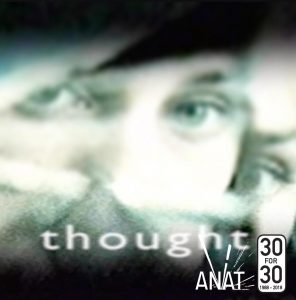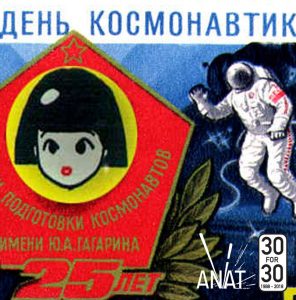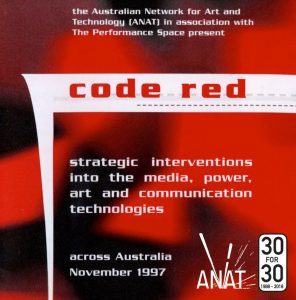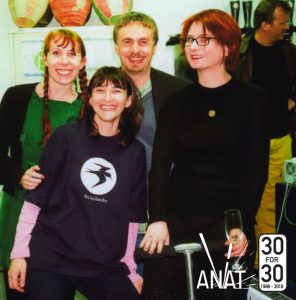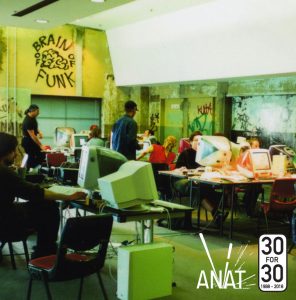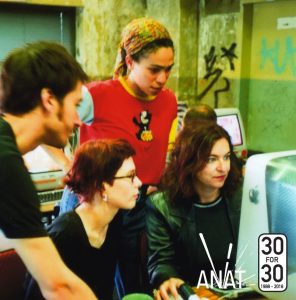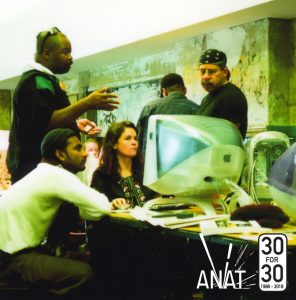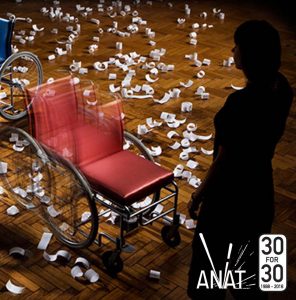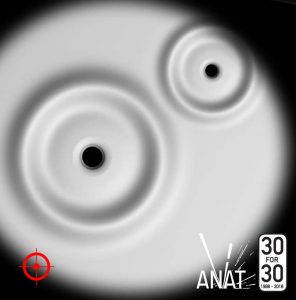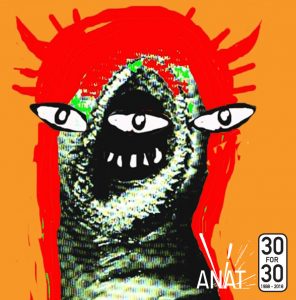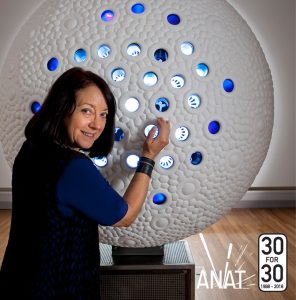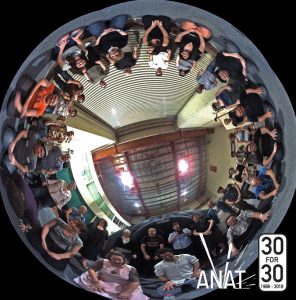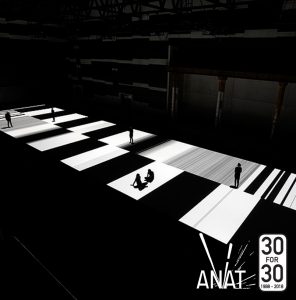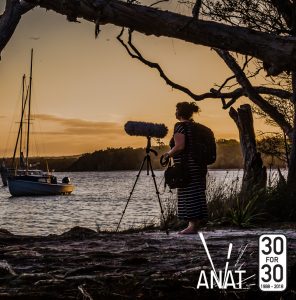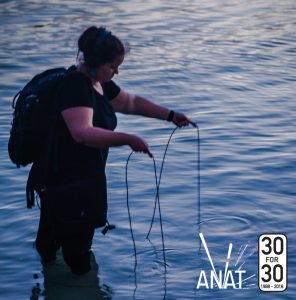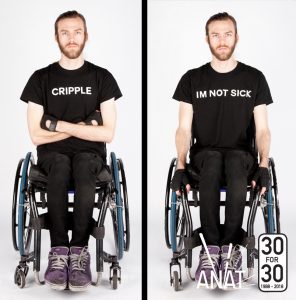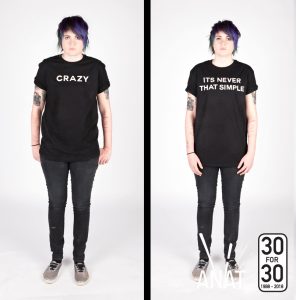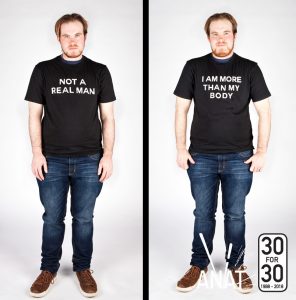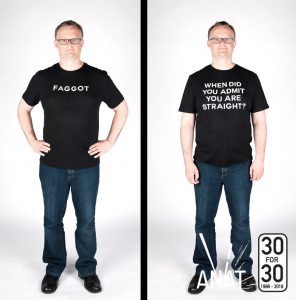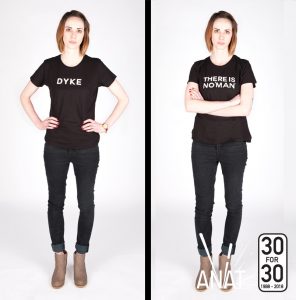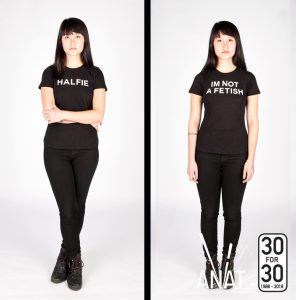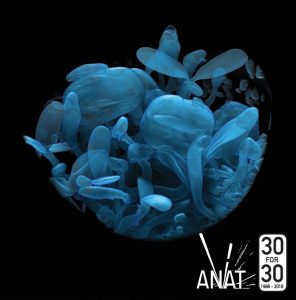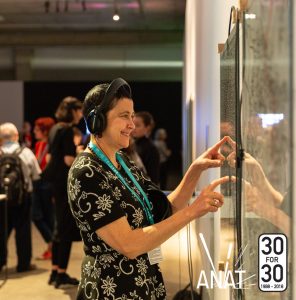ANAT 30 for 30: 1988 – 2018
In our 30 for 30 focus, we remember 30 watershed moments and stories celebrating ANAT’s 30th anniversary…
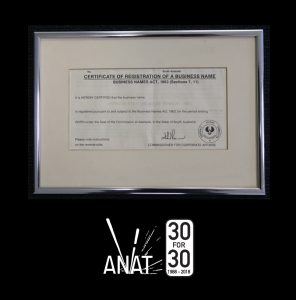 |
1988 :: Thursday 25 October
The seeds that grew into ANAT were sown by Interface, a suite of ‘art meets technology’ events developed by the Experimental Art Foundation, working with the South Australian Ministry of Technology, for Adelaide’s 1984 Festival of Arts. A pilot led to ANAT’s establishment in 1988 with a mandate to ‘promote, foster and develop … interaction between the arts, science and technology’. With these aims in mind, ANAT was tasked with: managing the Australia Council’s devolved Artists and New Technology Fund; collecting and disseminating information relevant to the field; maintaining a database of artists, institutions and organisations; publishing a regular bulletin; contributing to both Australian and international arts and technological publications; initiating and managing special projects; and providing information, advice and assistance to artists, educators and students. In its first year, Australian new media artists were invited to contribute to Imagescape, an event showcasing recent Australian works in film, video and computer graphics for the 1988 Adelaide Festival. And the very same year, FISEA (the First International Symposium on Electronic Art), was staged in The Netherlands, bringing together “scientists, artists and other specialists in the field of the electronic arts” in a “scientific, creative and educational forum”. The zeitgeist was underway! Image: ANAT’s certificate of incorporation |
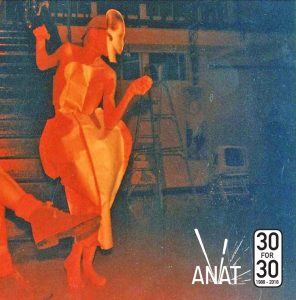 |
1989 :: Thursday 1 November
In its second year ANAT launched its National Summer School program, aiming to expand the palette of artists by helping them skill-up in the use of new technologies. Twelve artists, designers and performers from around Australia converged on Regency College of TAFE in Adelaide for the chance to experiment with a range of software and hardware. Researcher, artist, writer and performer Virginia Barratt was one of the 1989 Summer School participants. Virginia is a founding member of VNS Matrix, the influential cyberfeminist collective, and is currently undertaking a PhD at Western Sydney University.
#anat_australia #anat30for30 Image: Virginia Barratt and Adam Boyd, Dada Do, Eyeline Art Magazine Launch, School of Arts Building, 15 May 1987, Brisbane (photograph Jose Macalin) |
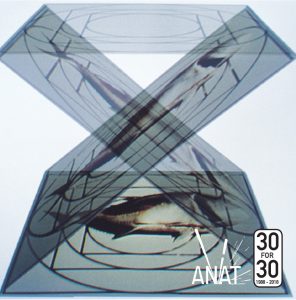 |
1990 :: Thursday 8 November In ANAT’s third year its exhibition Towards a New Aesthetic – Exploring Computer Aided Art featured big in AUSGRAPH 90, the art program of the Australasian Computer Graphics Forum’s annual conference, held in Melbourne. This second in ANAT’s ongoing program of exhibitions focussing on works that utilise technology—particularly those developed during / inspired by participation in ANAT’s national summer (and sometimes winter) schools—featured works by Adam Wolter, Diane Mantzaris, Hilary Archer, Linda Wallace, Lynne Roberts-Goodwin, Peter Charuk, Phil George, Phillip Bannigan and Sue Harris, Richard Guthrie, Rodney Harris, Sandra Shaw, Simryn Gill, Stelarc, Stephen Hennessy and Wendy Mills. Wendy Mills remembers the exhibition as “a productive follow-on from the summer school, in that it showcased a new direction that artists were exploring” and “reinforced a feeling of optimism in the potential for using computers in the arts”. On a personal note, Wendy feels the summer school and exhibition helped her shift the direction of her practice “from ‘real world’ installations to digital constructions and interactive artworks”. It wasn’t all good though, as back then, the equipment required to produce and show these works was still very expensive. Wendy had had to raise funds to produce her work, but during the exhibition equipment used in various artworks was stolen from the gallery. “The sound element of my work, which had been recorded live for the exhibition, was on a master cassette tape. This tape was stolen along with the cassette player, and never heard again.” That year, ANAT also organised a delegation to SISEA (the Second International Symposium on Electronic Art), which was again staged in The Netherlands. Image: Wendy Mills, memories of next easter, (1990), installation of transparent cibachromes and recorded sound, 400 x 400 x 400 cm (sound by Stephen Leek and VoiceArt) |
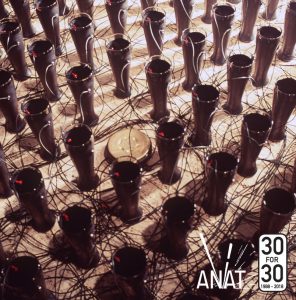 |
1991 :: Thursday 15 November Of the 62 artists who applied to ANAT’s Art Research and Development Fund that year, 10 were successful: Charles Anderson, Simon Carroll, Joyce Hinterding, Csaba Szamosy, Paula Dawson, Sally Pryor, Noelle Janczewska, Linda Johnson, James Harley & Shiralee Saul, and Stephen Hennessey. Joyce Hinterding’s experimental electro-acoustic work Siphon (pictured) explored the inherent qualities and characteristic sounds of electricity by sculpturally interpreting an electronic component within a sound-producing circuit. Joyce explains “this was a time when many people were tackling the building blocks of media and mediums; in my case electricity and the fabulously confusing water analogy was my starting point. I had been studying the Tafe electronics course when we were asked to repeat a turn of the century mathematical problem that calculated how much energy could be stored in a jar of water. This caught my imagination to such a degree that after calculating that I would need 300 jars to run a simple circuit, I set out to use this calculation to literalise the water analogy and the idea that energy flows. The result was Siphon, a work that gave the audience an experience of a literal filling and emptying of 300 glass jars with electricity. The entire room acted as and replaced a single component in the circuit, and gave agency to this invisible force through sound, and feeling as the room smelled and breathed with picofarads of electricity. “ Image: Joyce Hinterding, Siphon (1991) – detail (photograph Ian Hobbs) |
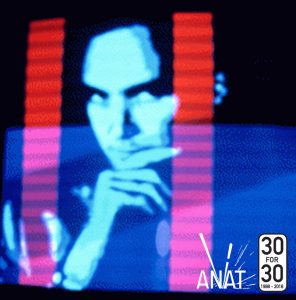 |
1992 :: Thursday 22 November Having organised an Australian presence at SISEA in 1990, ANAT was chosen to host TISEA (the Third International Symposium on Electronic Art). The first event of its kind to be staged in Australia (and the first ISEA hosted outside The Netherlands), TISEA invited Australian artists—and their audiences—to explore recent developments in art, science and technology, and their impact on the evolution of culture. TISEA revolved around two major themes. ‘Art and the Algorithm’ explored the critical role played by artists’ visual literacy in expressing and communicating esoteric data, while ‘Cultural Diversity in the Global Village’ highlighted the globally transformative impact of three decades of IT proliferation, and the role of artists in resisting the homogenising effects of the ‘global village’ and ensuring a future for the rich diversity of human cultures. The TISEA Coordinating Committee Chair was Gary Warner, with members Virginia Barratt, Rebecca Coyle, Paula Dawson, Tim Gruchy, Ross Harley, Jon McCormack and Bill Seaman. The symposium included presentations by artists including Simon Biggs, John Colette, Linda Dement, Ian Haig, Elena Popa and VNS Matrix. The performance program included notable performances by Rod Berry, Barbara Campbell, Stelarc, Amanda Stewart and Warren Burt. Stephen Jones’s film Artists in Cyberculture, shot during TISEA, examined the cultural, social and environmental implications of new technologies and featured many of the TISEA artists. Image: Tim Gruchy, Video portrait (1982) – still, (video synthesis by Stephen Jones, photograph by Pam Greet) |
 |
1993 :: Thursday 29 November In its sixth year ANAT curated Artists thinking about Science for the 1993 Great Australian Science Show. Held at the World Trade Centre, Melbourne and later toured to other states, the exhibition included works by Deborah Kelly, Dale Nason, Troy Innocent, Moira Corby, Faye Maxwell, Brad Miller and Jason Gee. Troy Innocent describes his work Idea-ON>! (pictured) as exploring “ideas for virtual worlds inspired of the first wave of VR” at a time when “a VR headset and the hardware to run it would cost in excess of a million dollars. Not having access to this tech at the time, I created interactions that explored the endemic properties of electronic space by emulating the language of VR via playable CD-ROM experience”. Through showing the work in the context of the Science Show Troy was able to observe “a range of different players experience the work in the different ways”, and this “became part of my creative research practice and an effective methodology for exploring possibilities afforded by interaction and game design”. Idea-ON>! was later released on the cover of Mediamatic and included in Burning the Interface exhibition at the MCA in Sydney: Read more about Idea-ON>! here Read more about Burning the Interface, The first major survey exhibition of works on CD-ROM by contemporary Australian and international artists, here Image: Troy Innocent, Idea-ON>! (detail), 1992, Database of experience, CD-ROM |
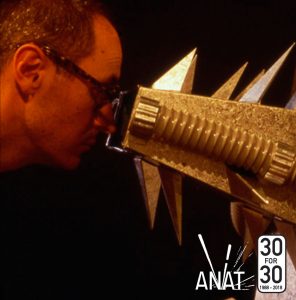 |
1995 :: Thursday 13 December Now in its eighth year, ANAT put together a program of screen-based new media work for the Australasian Interactive Multimedia Industry Association (AIMIA) conference in Adelaide. It featured works by Kim Bounds, John Colette, Linda Dement, Ian Haig, Troy Innocent and Elena Pope, Faye Maxwell, MindFlux, Bill Seaman and John Tonkin, as well as The User Unfriendly Interface (pictured) by Josephine Starrs and Leon Cmielewski. ANAT also convened a special panel at the conference on artists’ use and development of technology, chaired by multimedia producer Simon Edhouse. Presentations by Leigh Hobba, John McCormack and Josephine Starrs sparked questions from the audience on issues including the politics of authorship, relations between artists and the multimedia industry, intellectual property, moral rights of artists and copyright. ANAT’s presence in the public domain took a great leap forward that year with the launch of its website, designed by the ubiquitous cyber-entrepreneurs Virtual Artists (Jesse Reynolds and Dave Sag). And as 1995 came to a close, ANAT launched an international artists project—designed to bring artists and writers to Australia to present their work and meet with Australian practitioners—with Francesca da Rimini’s curation of Virogenesis (1995–96). Image: Conference-goers exploring The User Unfriendly Interface by Josephine Starrs and Leon Cmielewski |
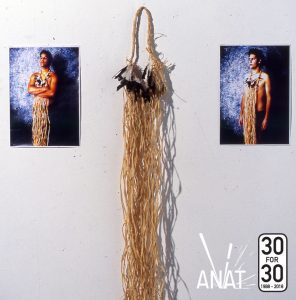 |
1999 :: Thursday 10 January
The inaugural National Indigenous School in New Media Art—the first ANAT Summer School to be dedicated exclusively to Indigenous artists—focused on helping participants to develop digital arts practices by providing access to appropriate training, computer equipment and software. It took place at Northern Territory University, Darwin in July and was project-managed by Indigenous (Gurindji) artist, curator, writer, lecturer and consultant, Brenda L Croft. With support from the Emerging Artists program run by the Australia Council’s Visual Arts/Crafts Fund, ANAT then initiated a series of follow-on residencies specifically aimed at website development. NT-based Jason Davidson-Hampton’s site, for example, was based on stories and imagery from the Kimberley region, while Victorian Christian Thompson’s featured a series of text-based works exploring knowledge, literature, and the importance of theory for Indigenous people and academics. These were created during residencies at 24Hr Art, Darwin and the Centre for Contemporary Photography, Melbourne respectively. 1999 also saw the inauguration of ANAT’s Scientific Serendipity residency program, aimed at facilitating mutually beneficial collaborations between artists and scientists. View Jason Davidson (NT) at 24Hr Art, Darwin, website based on stories and images from the Kimberley region here Image: Christian Thompson, Urban Murri’s (1999), digital images, raffia, magpie feathers |
 |
2001 :: Thursday 24 January
The Scientific Serendipity residency program, initiated in 1999, culminated in 2001 with two Australian artists taking on residencies in scientific organisations. During a residency at the Museum of Natural History in New York, Sydney/New York-based Justine Cooper assisted with the year-long Genomic Revolution exhibition, and also developed her work Transformers, which was exhibited in the 2002 Adelaide Biennial of Australian Art. Justine also came very close to the event that dominates our collective memory of 2001. She remembers: “That year I also had a six-month studio space residency on the ninety-first floor of the World Trade Center, with a dozen other artists. At the Museum I’d been working on the Genomic Revolution exhibition, learning to extract DNA from saliva and also how to think about genetics conceptually and ethically, and helping set up their public Genome Learning Laboratory. That’s where the photo with Dr Jim Bonacum was taken. I think my husband Joey Stein took the photo. We met at the museum, so I can thank ANAT for that as well ;-)” “After 9/11, in which I lost a colleague and also much of my work, I shifted the project I produced related to the World Trade Center. I’d read the sequence of Tower One’s office lights as if they were an autoradiograph, which is an old form of DNA mapping, and had synthetic DNA made from the sequence I mapped – so I ended up with a biological transcription of the absent building. The ANAT residency absolutely informed that work, which was called Evanition.” Meanwhile Brisbane-based Adam Donovan spent three months at the Maritime Acoustics Division of the DSTO (Defence, Science and Technology Organisation) in Adelaide. The collaborative relationships he established with scientists there were instrumental in his development of ‘audio spotlights’ (ultrasound sound projectors) which, again, featured in the Adelaide Biennial the following year. Read Justine’s description of the work here. Scientific Serendipity also led to the initiation of Synapse—an Australia Council / Australian Research Council (ARC) initiative for multidisciplinary linkage grant applications—which was to enable new media artist Mari Velonaki to work with field robotics experts on her interactive work Fish-Bird (see our 2003 post in two weeks for more details). Image: Justine Cooper with Dr Jim Bonacum during her residency at the Museum of Natural History, New York (photograph Joey Stein) |
 |
2002 :: Thursday 31 January
BORDERPANIC, held in Sydney in September, brought together artists, media makers and thinkers questioning the world’s geopolitical and metaphorical borders. It was initiated by Performance Space and curated by Zina Kaye and Deborah Kelly. As Deborah remembers: “BORDERPANIC began as an exhibition and grew into a kind of festival (though that word lends a misplaced sense of festivity). Fiona Winning at Performance Space invited me to curate a cultural response to Australia’s disastrous refugee policies, which felt so urgent in the wake of Tampa, the ‘children overboard’ debacle, and the drowned hundreds who had perished when the SIEV X sank. I asked Zina Kaye to work with me, and she brought with her an association with Amsterdam’s Next 5 Minutes festival, which we became an arm of.” “Over nearly a month we pulled together: an exhibition featuring wildly diverse artworks – from coffee-on-tin imaginary landscapes by asylum seekers incarcerated in Villawood detention centre to Hossein Valamanesh’s iconic burning carpet (pictured) – which was accompanied by a video screening and presentations at Performance Space; a tactical media lab and symposium hosted by the Museum of Contemporary Art; a forum at Metro Screen; a sprawling website; a little book; workshops; and a postcard competition held in conjunction with Avant Cards.” “We thought we were part of a popular movement that would gather power, mass and persuasiveness. We thought that by now, things would be better. That we would be better.” Image: Hossein Valamanesh, Longing belonging (1997) colour positive print, 99 x 99cm. Photograph Rick Martin. |
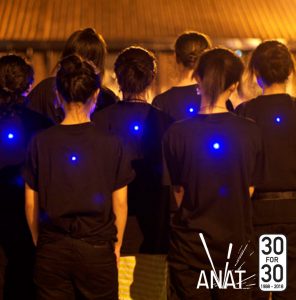 |
2007 :: Thursday 7 March
Until now ANAT’s Emerging Technology Labs had focused on introducing the skills associated with emerging technologically-based practices to Australian media arts practitioners, writers and curators, but in 2007 the reSkin wearables research and development laboratory, presented at ANU in Canberra, extended the reach to include design and craft practitioners such as jewellers, fashion designers and object makers. Twenty national and international artists and designers investigated the dynamic field of wearable technologies over a three-week intensive period, under the guidance of international leaders in the field Joanna Berzowska (Canada) and Elise Co (USA), while national facilitators Susan Cohn and Cinnamon Lee were assisted by sound artist Alistair Riddell and media artist s Stephen Barrass to cover the diverse skill bases associated with the field and informing the development of the lab. The lab was hugely popular with participants, facilitators and project partners alike. According to facilitator Joanna Berzowska, the high quality prototypes developed during reSkin heralded the advent of a ‘third wave’ in the field of wearable technology, in which the conceptual resolve and use of applicable materials technologies was, for the first time, married with high-end craft and design skills. Image: Michael Yuen, Black Tee prototype developed during reSkin
|
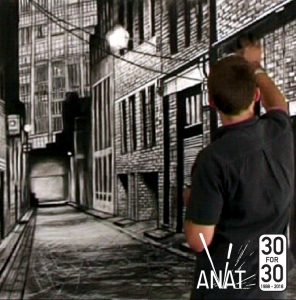 |
2011 :: Portable Worlds In 2011 ANAT partnered with Country Arts SA to present the Portable Worlds 2nd Edition 2011 Tour throughout regional South Australia. Featuring works created and/or displayed on mobile phones, Portable Worlds had been touring urban and regional Australia since 2008, exploring connection and intimacy, portability and community, scale and distance. In his work ‘Detour 27’, participant Thom Buchanan combined drawing and video to literally ‘draw’ himself into his work. Looking back, he reflects: “As a layered response to the process of making a piece of art my work aims to reveal the beauty of a lived environment. Making myself a subject within the work allows me to visually explore my own life’s journey and how certain events have shaped me. I have used modern technologies – digital media – coupled with the oldest of mediums – charcoal and paper – to create an imagery that can be read beyond the surface. These drawings are held in a constant state of flux, erased and reworked until the last moment when I walk into my world. This work opened a major door to my practice. Looking back, it’s amazing the journey it sent me on. kind regards thom” You can view Thom’s work Detour 27 here Image: Thom Buchanan, Detour 27 (2011), video/animation – still |
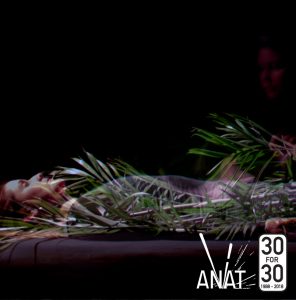 |
2015 :: The Art of Pain Timed to coincide with National Pain Week, The Art of Pain discussed contemporary pain research and its implications via an exhibition, an expert conversation, and panel discussions revolving around the experience and management of pain. It was presented by ANAT, The Bob Hawke Prime Ministerial Centre and Pain Adelaide, and supported by the Australia Council for the Arts. Somatic Drifts, presented by Art of Pain participant Cat Jones, came out of her 2014 Synapse Residency at the School of Medicine and Pharmacology, UWA (see last week’s post). This sensory, one-to-one artwork and accumulative audio-visual installation explored trans-human and inter-species empathy, by enabling each participant to experience the bodies of other entities through body illusion and touch. Bodies and narratives travelled beyond their own boundaries to ask: What realm does the human body exists within? How far can we drift? What can this drift enable us to change? Cat recalls that during the Synapse research phase she was “devouring research papers and meeting with a stream of clinicians, researchers and health workers”, feeling like a “strange kind of pollinator – seeding ideas for some and transporting new research between them.” Later, she found performing Somatic Drifts to be “euphoric, like many of the participants I lose sense of time and space, real and virtual, and a blurring of their body and mine. Its concepts live across multiple planes too – sensory art, pain science, vegetal cultures, queer thinking, very personally in participant’s lives and within mine.” And this year, half a decade after Cat’s Synapse Residency, “we’ve published new research that came out of my observations” and “I’ve discovered that I have ‘mirror touch synaesthesia’ …” You can view documentation of Somatic Drifts here In 2015 ANAT also partnered with three other organisations to host Unfixed, a residency for Deaf and disabled artists from Australia and the UK. See next week’s post for more on Unfixed and its 2016 UK follow-up, Unlimited. Image: Cat Jones, Somatic Drifts (2014), installation view (sound design Melissa Hunt) |
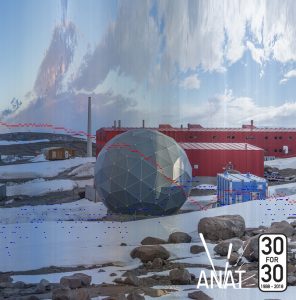 |
2017 :: Australian Antarctic Division & CSIRO
In 2017 ANAT increased its engagement with federal science and research infrastructure via new fellowship and residency programs. The successful recipients of ANAT’s inaugural Synapse CSIROResidencies were three artists. Anton Hasell worked with Daniel East and the Lab 22 – 3D Printed Structures research team, while Jiann Hughes worked with Xavier Mulet, JJ Richardson and the Metal Organic Frameworks research team, and James Geurts worked with Richard Evans and his Polymer Coatings for Cell Adhesion research team. The Australian Antarctic Arts Fellowship, originally established by the Australian Antarctic Division, enables members of the creative community to experience Antarctica firsthand, then share this with the broader Australian community through their practice. Photographer Martin Walch– a specialist in time-lapse and still photography – was awarded the first AAA Fellowship administered by ANAT, and spent three months at the Mawson research station capturing the unique icy environment on camera. Martin remembers: “My first encounter with ANAT was being selected to participate in their fifth National Summer School in Computer Aided Art and Design, held at Curtin University in 1994. Having trained as a photographer during the final decade of analogue dominance, what I learned from my tutors and fellow students completely transformed my practice, setting me up to meet the challenges and frustrations of early digital technologies with a powerful DIY attitude to problem solving, and the realisation that I was now part of a supportive and vibrant community that had something it wanted to contribute to the world. “Fast forward to November 2017 and I’m standing on the deck of the Aurora Australis as we sight the Antarctic continent for the first time. ANAT’s support via the fellowship was key to achieving the goals I’d set in my application. Amongst other things, it allowed me to rapidly construct blizzard-proof camera housings for my time-lapse cameras at Mawson Station, as well purchasing terabytes of drive space for my data archive. I cannot thank ANAT enough for the support I’ve personally received over the years, and for the central role the organisation has played over the last three decades, as our national champion of interaction between the arts, science and technology.” You can read the CSIRO residents’ blogs here: Visit http://archive2019.anat.org.au/anat-30-for-30-1988-2018/ Image: Martin Walch, ‘Terra-Antarctica_Time-panorama_Mawson_Station_60 days_20171208- 20180205’, (2017-18) – still courtesy of the artist. |

